경기문화재단
Culture In the Future
Major Policy Direction for the Development of Arts and Culture in GyeongGi-do Province
Cultural Policy is a quarterly magazine published by the Gyeonggi Cultural Foundation since the summer of 2017 with the purposes of identifying new trends in cultural policies at home and abroad, gathering the opinions of experts in relevant areas, and introducing the directions and contents of diverse cultural policies promoted by Gyeonggi Provincial Government and Gyeonggi Cultural Foundation. |
Established by GyeongGi-do Province in 1997, GyeongGi Cultural Foundation is Korea’s first cultural foundation. The Foundation has engaged in the following activities :
1. Support GyeongGi-do's residents in creating works of arts and culture and disseminate them.
2. Give residents more opportunities to enjoy culture.
3. Discover and conserve cultural heritage.
4. Clarify and strengthen GyeongGi’s identity. Since 2009, the Foundation has run a
dozen
of provincial museums and centers (e.g.
GyeongGi Provincial Museum, GyeongGi
Museum of Modern Art and Nam June Paik
Art Center), upon request.
It has been a year since Mr. Sul Won Gi was appointed as the president of GyeongGi Culutral Foundation. After graduating from Beloit College and the graduate school at Pratt Institute in the US, Mr. Sul has served as a professor at Duksung Women's University, director of the Plastic Arts Department at the School of Visual Arts at Korea National University of Arts and director of the research center at Korea National Institute for the Gifted in Arts. It is the first time for the Foundation to have an artist as its president. We thus invited the president to reflect on his first year at the Foundation and to share his expectations for his next year, regarding his cultural policy suggestions for GyeongGi-do Province.
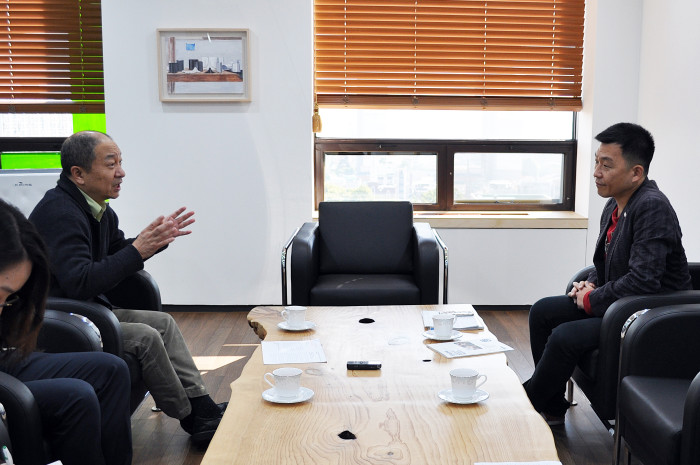
Reporter Ann Young ro(ANN) Mr. Sul, it has already been a year since you came to the Foundation. What is your impression of your first year at the Foundation?
Mr. Sul Won Gi (SUL) Well begun is half done. Half done is the end. Time flew like an arrow. What is important to discuss on culture is not just to encourage people to visit performances and exhibitions but to help them give value to their daily leisure activities. I’d like to share culture in this way until the end of term. Public institutions should be commensurate with this goal and cultural planners need to play more active roles in this regard. This may not easy for public institutions evaluating activities with numbers but we need to have patience and move forward. This is what the Foundations’ Local Intermedia Team does. The Foundation needs to suggest evaluation criteria for individuals’ activities I mentioned before. There have been efforts to suggest them but it is still not easy to convince those in charge in order to benefit from concrete support or budget allocation.
ANN What might culture look like in the near future? Could you share your personal view?
SUL It is similar to arts and culture education. In the past, we accumulated technical knowledge and passed them on to next generations. However, changes started 20 years ago in Korea and 40 years ago in other countries. Instead of teaching students to “do something,” the education system came to focus on processes by teaching them to set goals and to achieve them.
We also need to reflect on what goals are appropriate for arts education in the future. The appearance of post-modernism didn’t mean the disappearance of modernism. Although post-modernism consists in being free from discussing ranks, that is not the case. Thus, if a goal can be set freely by anyone and if it gives him or her enthusiasm for achieving it, that goal could be regarded as valuable.
The same is true for culture. We must not set goals and force people to achieve them. In the future, anyone should be able to set goals for their culture. Since I work for a public institution, I inevitably think about policy. If we make efforts to support cultural planners, we will be able to form a culture in which each individual (citizen of Korea or resident of the province) can make his or her own choices. That will be the culture of the future.
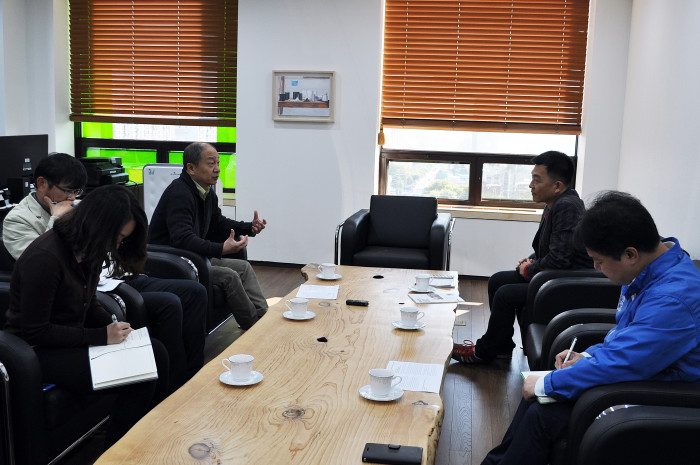
ANN I would like to ask you what you want to do if you are allowed to serve as the president of the Foundation for ten years.
SUL I would like to form a conceptual basis and establish a system that could put the concept into practice. There is a book called Good to Great, an American book on business management. The book suggests the concept of I.O.O.I (Input, Output, Outcome, Impact) and this term is very important for the management of a public institution. In most cases, people evaluate only I.O.O.I but they don’t evaluate impacts. I want the Foundation to put more emphasis on impacts.
It is also necessary to establish a system accumulating intellectual assets. The Foundation is somewhat weak in this and it actually takes at least five years to have the system. For example, the chairman of the Japanese retail company Muji has a management concept of putting everything into a system because the company’s staff won’t be able to work in the same field for the rest of their life. To be more specific, an employee makes his or her own manual to give it to his or successor. Building on this manual, the successor then makes his or her own manual. For the rest of term, I would like to suggest some directions like the business attitude of emphasizing impacts and accumulation of intellectual assets and share with the staff.
To do so, I’m planning to encourage our team leaders to actively participate in the leadership training program between the winter and early next spring. in order to motivate them to change their concept. My two-year period at the Foundation won’t have any long-term effect. So there must be a system that can help anyone at the Foundation generate effects themselves, so that whoever serves as its president, the system can continue to function.
As a person in charge of the management of the Foundation, I would like to introduce them the book Good to Great, emphasize the fact that they need to lead the Foundation in this way and encourage them.
For the president of the Foundation, relationships with the provincial assembly and the provincial government are important. So this position needs someone with administrative experience. In other words, he or she needs to understand both his or her job at the Foundation and the external relations of a public institution.
ANN I would like to ask you to elaborate on the Foundation’s future vision and major policies for GyeongGi’s arts and culture.
1. GyeongGi-do Province, a great place to live in thanks to culture.
2. Effectively realize the development of GyeongGido Province’s cultural policies and its missions.
3. Adopt the cultural impact assessment system and discover and spread globally competitive cultural content.
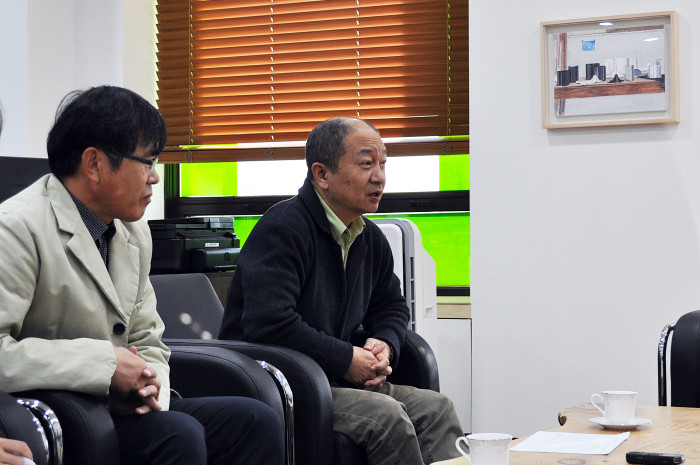
SUL I believe that GyeongGi Cultural Foundation is at the center of GyeongGi’s arts and culture. Established with a goal of making GyeongGi-do Province a “great place to live in thanks to culture,” the Foundation is the province’s core institution of its culture. GyeongGi Cultural Foundation’s uniqueness and mission reside in successfully conserving and managing each area’s cultural content reflecting cultural diversity and raising the content to the status of arts and culture in order to improve local residents’ quality of life and happiness index.
In an attempt to realize its vision and mission, the Foundation has set four core values: sharing, communication, changes and professionalism. Considering the environment in and out of itself, the Foundation has also come up with its specific policy directions called 5Cs+3Ms. First of all, the Foundation’s internal environment is divided into three categories: man, mechatrix and money. Meanwhile, its internal and external environment has five elements: credibility, conservation, capacity building, communication and community. This is to ensure a virtuous cycle in running the organization.
In order to realize GyeongGi-do's cultural policy development and mission in an effective manner, the Foundation has a policy office directly run by the president. The office has the Culture and Arts Promotion Committee and Museum Operation Committee. It is implementing specific policies by communicating with experts and by building the staff’s capacity.
The Cultural Policy Forum discusses major strategic projects that are carried out in line with policy directions. The Forum’s diverse results are published in the Cultural Policy Bulletin. Moreover, major content that was suggested at the Forum leads to specific projects. In this process, the Foundation is making every effort to ensure local residents’ “cultural happiness.”
Meanwhile, the Foundation has recently conducted a pilot operation of the Cultural Impact Assessment system. Among Korea’s local governments, GyeongGido Province was the first to adopt the system. By running the assessment system, the Foundation is willing to support the process of naturally forming an environment favorable for residents’ cultural activities. It would also like to diagnose and assess the province’s new plans and policies to see how they will affect residents’ quality of life from a cultural perspective. Finally, the Foundation is there for them to suggest policy alternatives if necessary.
There is an event shared with local residents called the “2018 GyeongGi Millennium Project.” In 2018, it will have been thousand years since the name “GyeongGi” appeared in Korea’s history. GyeongGi-do Province and the Foundation are preparing the project to help residents feel and enjoy GyeongGi’s culture. The project’s representative events include the “GyeongGi Millennium Platform”, “People Proposed Projects” and “GyeongGi Millennium Picnic”
It was difficult to convince people of the concept of gathering small ideas. Some say that a project without a result is a failure. However, the process can be more important than the result so I believe that it is important to experience this. Since the project is a new attempt targeting the entire province of GyeongGi-do so it may fail but even in that case, I don’t think that it will be a real failure.
Meanwhile, we often hear the expression “global” recently. It could be interpreted as “universal and outstanding.” GyeongGi-do Province is full of globally competitive cultural content. In this context, the Foundation’s major role is to support and disseminate cultural and artistic creation, to give people more opportunities to enjoy arts and culture, to discover and conserve cultural heritage and to clarify and promote GyeongGi’s cultural identity.
In 2014, the Foundation was running Namhansanseong Culture and Tourism Initiatives. By effectively running the organization, the Foundation succeeded in inscribing Namhansanseong Fortress on the UNESCO World Heritage List after fierce competition.
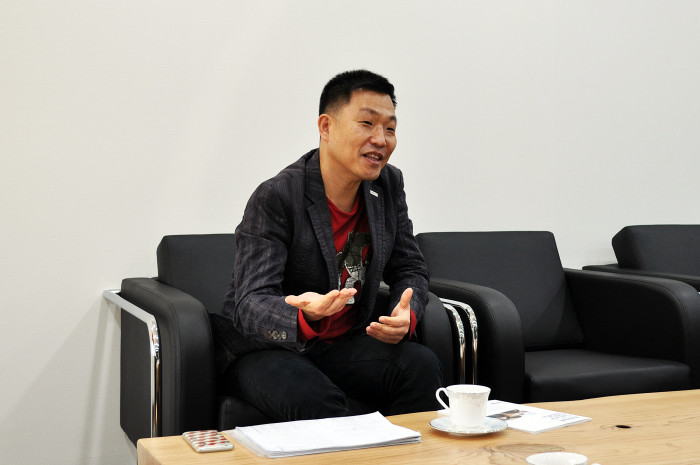
ANN Could you please be more specific? What policy direction is the Foundation taking in order to share the value of arts and culture with local residents?
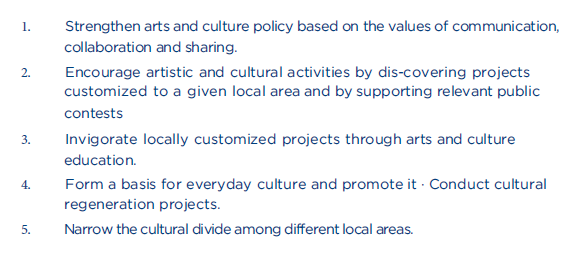
SUL First, we would like to promote arts and culture by discovering locally customized projects and supporting public contests in order to invigorate local culture. The Foundation has conducted a project supporting public contests to promote arts and culture since 1997. It is the Foundation’s own project that supports the activities of GyeongGi-do Province’s arts groups and artists. The purpose of the project is to invigorate the country’s arts in the mid to long-term and to improve artists’ self-sufficiency by establishing a system that allows creative programs to be presented and distributed. Examples of this project are as follows: 1. GyeongGi Literature: collection series of works by new and existing authors. 2. Saeng Saeng Hwa Hwa: exhibition of visual arts works by promising artists. 3. Gyeong- Gi Performing Art Showcase and GyeongGi Performing Art Festa: Programs in the field of performing arts. Meanwhile, special arts and culture projects such as Nomadic Gyeong- Gi Art Festa have constituted a success story of organizing an arts and culture festival in collaboration between local arts and culture communities and local governments.
Second, the Foundation is also carrying out locally
customized projects through arts and culture
education. This is about supporting arts and culture
education programs that are closely linked to a given
local community. Diverse local organizations and institutions
serve as strategic points of arts and culture
education in order to create an environment favorable
for local residents’ continuous participation in artistic
and cultural activities. This project is encouraging creativity
and artistic sensitivity through local areas and
adding each area’s unique colors of arts and culture to
their new community value.
Third, the Foundation is forming a basis for everyday culture and spreading the culture under the Local Culture Promotion Act while also carrying out cultural regeneration projects. The culture in daily life project consists in encouraging local residents to become and serve as main participants of local culture. Through various projects, GyeongGi Cultural Foundation is encouraging local residents to grow and serve as GyeongGi cultural leaders. Among these projects, the foundation is conducting a policy study on how culture is integrated into daily activities in order to develop cultural indicators, and it is working to build a cultural collaboration network that can bridge the information divide. It is also organizing a platform to build culture that can become an integral part of residents’ lifestyles by fostering creators and consumers of culture. Through the deployment of cultural and art groups, the foundation hopes to give citizens more opportunities to enjoy GyeongGi culture and to link cultural groups with related organizations. A series of analyses of culture in daily life has been designed to change common perceptions of a daily approach to culture and share the value and purpose of culture with the public.
In an attempt to establish an effective everyday culture network and support system, we are using public facilities, unused spaces and abandoned spaces as everyday culture facilities. Moreover, we are planning to equip the everyday culture platform with networking space for everyday culture clubs and shared equipment in order to increase strategic points connecting everyday culture, creation and jobs. GyeongGi’s provincial museums and art museums that belong to the Foundation could also serve as strategic points on the everyday culture platform. The purpose of cultural regeneration projects is to encourage local residents to take the lead in restoring their local communities. As an alternative making up for the limits of the existing urban regeneration projects, such cultural regeneration focuses on nurturing active participants in the local cultural spectrum so that they can participate, produce and collaborate actively, thus contributing to the seamless functioning of the cultural ecosystem.

One of the exemplary cases is the city of Lodz. Also known as a “Manchester in Poland” in the 19th century, this city used to be a center of textile industry. As time passed and the industrial environment changed, the city’s textile industry collapsed, thus letting its about 300 factories neglected for dozens of years. Under these circumstances, the municipal government of Lodz chose remodeling instead of redevelopment. With their existing red bricks intact, the city’s factories were transformed into houses, hotels, galleries, convention centers, shopping malls and museums. The Manufaktura, which had been transformed from an industrial complex of 13 buildings into a zone of culture, shopping and entertainment, became the city’s landmark. Since the launch of urban regeneration in the late 1990’s, Lodz became a center of culture, logistics and business process outsourcing.
Such cultural regeneration requires three tasks: 1. Discovery of local cultural resources. 2. Regeneration of local hubs. 3. Creation of each town's culture. As part of the “discovery of local cultural resources,” a project called “Visible Town” supports local organizations and residents
Meanwhile, “G-Open Studio : Artist Next Door” is about sharing artists’ everyday life in their studio with the public. To regenerate local strategic points, GyeongGi Cultural Foundation is running six “Creative Centers” in the province. As for the creation of village culture, there is a project called “Beolteo Culture Creation Project” which forms a basis for creative activities using arts and culture through space operation, public design, community programs and research on villages. In addition, GyeongGi Creation Center has carried out projects reilluminating and reinterpreting local history in cooperation with residency artists and local residents. Furthermore, the “GyeongGi Harbor Eco- Museum” project is a representative case of forming a consultative body with the local community in order to conserve and utilize with residents the area’s nature, local heritage worth conserving and culture.
Northern GyeongGi has great potential and future value in that the area is an outpost of the Korean reunification, virgin soil of natural environment and a site conserving traditional culture. Considering such characteristics of Northern GyeongGi, the Foundation has served as a platform of arts and culture for the invigoration of local culture, training of young cultural planers as driving forces and projects supporting new businesses and invigorating traditional culture.
GyeongGi Sangsang Campus, which has been run by the Foundation’s Local Intermedia Team recently, was designated as an exemplary case of balanced development projects in 2017 following the policy assessment of Korea’s presidential local development committee. The Campus was able to be designated because it carried out cultural regeneration to transform an industrial complex and unused industrial facilities to form space for young people and to encourage young people’s culture.
Cultural Policy Bulletin Vol.2 E-book
<ggc의 모든 콘텐츠는 저작권법의 보호를 받습니다.>
- 글쓴이
- 경기문화재단
- 자기소개
- 경기 문화예술의 모든 것, 경기문화재단